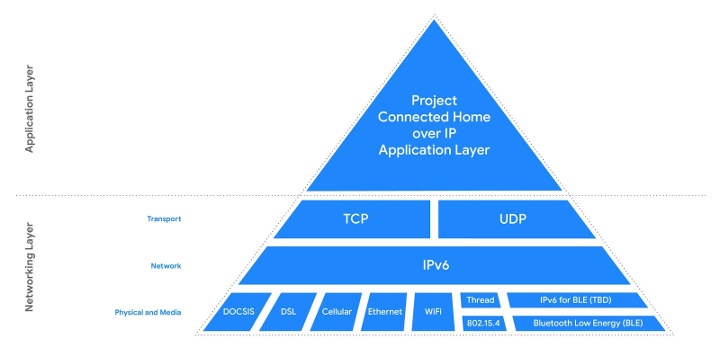Amazon, Apple, Google, and Zigbee Alliance have partnered to create Project Connected Home over IP (CHIP) working group aiming to develop a royalty-free, Smart Home standard to increase compatibility among products, and with security at the forefront.
The new standard will be separate from Zigbee 3.0 / Pro, and Zigbee Alliance board member companies such IKEA, Legrand, NXP Semiconductors, Resideo, Samsung SmartThings, Schneider Electric, Signify (formerly Philips Lighting), Silicon Labs, Somfy, and Wulian will also join the CHIP working group and contribute to the project.

The standard specified by Project Connected Home over IP will rely on existing technology from the networking layer including TCP/UDP transport protocol, IPv6 network and various physical & media standards such as WiFi, Ethernet, Bluetooth LE, Cellular, 802.15.4 and others.
Instead, it will define what happens at the application layer level with the following points of focus:
- End-to-end data security and privacy among in-home and mobile devices, and cloud services.
- A unified and standardized baseline set of out-of-box setup components.
- Platform and ecosystem-agnostic technology (any device, any ecosystem).
- Reducing one-off gateways and translators by building upon IP
- A consistent programming model for devices, mobile, and cloud.
Project CHIP will not attempt to standardize the user interface, only communication between devices to improve interoperability. The new Smart Home standard will eventually be implemented in Amazon’s Alexa Smart Home, Apple’s HomeKit, Google’s Weave and leverage the Zigbee Alliance’s Dotdot data models.
The first draft specification and a preliminary reference open-source implementation are expected in late 2020. You’ll find more details on the official website.

Jean-Luc started CNX Software in 2010 as a part-time endeavor, before quitting his job as a software engineering manager, and starting to write daily news, and reviews full time later in 2011.
Support CNX Software! Donate via cryptocurrencies, become a Patron on Patreon, or purchase goods on Amazon or Aliexpress




